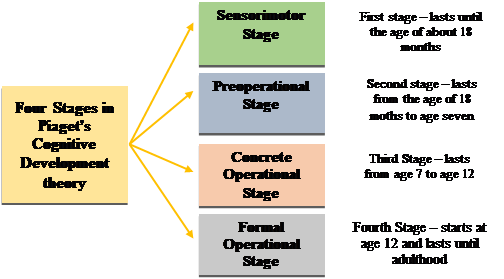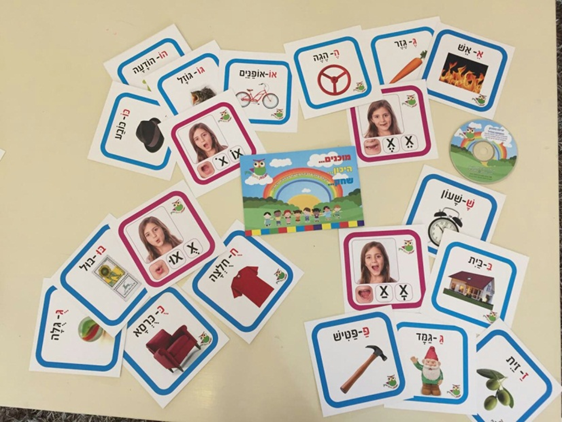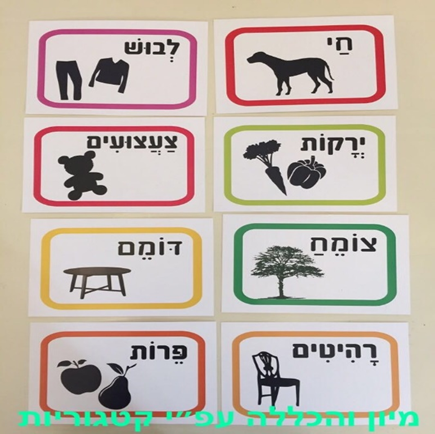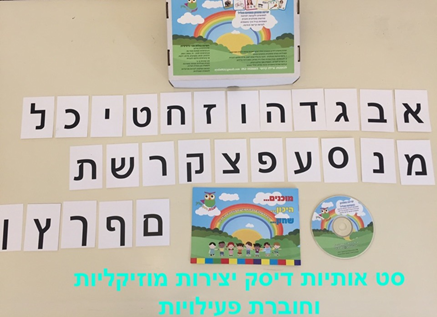Abstract
This article describes the process of developing a play kit to help kindergarten children acquire literacy. Studies show that play is an essential, significant, universal and experiential activity shared by all people. On the face of it, play is a simple and trivial activity, although understanding that play has a significant positive effect both on children's functioning in the 'here and now' and on their future development leads to a theoretical and profound research-based approach to the subject of play. This article presents the findings of a qualitative research carried out as part of a mixed method ongoing doctoral research whose aim is to investigate the contribution of an educational intervention program for kindergarten children to develop cognitive and emotional skills in preparation for the transition to Grade I. The qualitative research relied on semi-structured interviews with kindergarten teachers who participated in the aforementioned intervention program and observations of kindergarten teachers' work in a kindergarten with about 140 children. Eight themes emerged from content analysis: expectation of the program, attitudes toward the role of kindergartens in the transition to First Grade, the nature of the transition, partners in kindergarten teachers' work, emotional readiness, cognitive readiness, means of implementation, and the image of kindergarten graduates. These themes served as principles for structuring a play kit to develop literacy among kindergarten children approaching transition to First Grade.
Keywords: Transition from kindergarten to schoolplayliteracy developmentintervention programcognitive skillsemotional skills
Introduction
In the intervention program I developed, intervention is direct and integrates games through movement and developing coarse motor skills. The program's aim is to guide kindergarten teachers how to nurture control of skills that help learn the written code, which is the basis of literacy, to promote motivation to read and write and how to enrich children's language so as to support their abilities to understand and express themselves and their communication skills in general through play and movement and not in a formal and didactic manner.
Fundamentally, the program is based on the view that literacy development begins long before entry to school, and that kindergarten teachers can be part of this developmental process and nurture literacy gradually and rationally (Ravid, 2003). The program lays before teachers the skills and talents the develop at a young age that create the infrastructure to acquire reading and writing and school. Program activities refer to developmental milestones, and are adjusted to children's abilities across a range of ages in every area, meaning, cognitive, emotional, social and motor.
Many developmental theories have focused on early childhood. The concept 'development' refers to change or growth that takes place in children. It begins with infancy and continues until adulthood. Research on child development focuses on three main areas - physical, cognitive, social and emotional.
Child development depends on physical maturity that is a sequence of biological changes. These changes help children in their lives learn and develop new skills and abilities and are dependent on changes in the brain and nervous system. Nonetheless rich learning surroundings help these abilities in children to develop their ability to think, their motor skills and their potential in their early years
Theoretical foundation and related literature
The theories on which this research is based focus on studies carried out over the years that review key theories in early childhood.
The theory of children's intellectual (cognitive) development, which is considered to have the greatest effect, is Piaget's theory.
According to Piaget (1958) children are not passive to their environment. Just the opposite: they examine their environment, seek solutions actively and of course - ask questions. Piaget focused on cognitive processes of collecting knowledge and its processing (and not knowledge that children acquire). He compared intelligence development to physiological development. Piaget's theory (like those of Freud and Ericson) discerned four key stages of intellectual (cognitive) development. At each stage children acquire new intellectual skills, based on previous stages

Although each stage is fixed, each individual has his or her personal speed. In addition, there are interpersonal and intercultural differences during each stage.
Piaget maintained that our ability to think develops with age and is a result of reciprocal activities with the environment. What does this mean? The environment, as you know, inundates us with stimuli all the time, whereas we react to these stimuli, initiate, change and take part in what is occurring in our environment. Reciprocal activity leads to learning.
Another developmental theory is that of Vygotsky (1978) stating that learning is correlated to development. Development is not seen as separate to the learning process. Learning is what allows development and thus precedes it; development depends on learning. Vytogtsky's view can be seen in the following example - "zone of proximal development". Let us assume, Vygotsky says, that we are examining 10-year old children to determine which class they suit. And let us assume that test results were the same for two children: mental age - 8. This of course means that both are capable of coping with tasks with a difficulty level suitable to eight-year old children. Does this mean, asks Vygotsky, that these two children should be placed in the same educational framework? Is the conscious development process of the two identical? Is their conscious ability the same?
Let us assume that diagnosis continues and the children as asked to cope with new tasks, but this time they are helped by an adult. It is found that with help, one child can cope with tasks at an 11-year old level and the other copes with tasks at a 9-year old level, do these children have equal mental ability? The difference between the first and second grades received by each child is defined by Vygotsky as the "zone of proximal development": "the distance between the actual developmental level as determined by independent problem solving and the level of potential development as determined through problem solving under adult guidance, or in collaboration with more capable peers" (Vygotsky, 1978, p. 86).
Zone of proximal development expresses those same essential functions that have not yet matured, but are in the process of maturing. These are the first signs of development and not its fruit. Only with the help of interaction with the human environment (learning) will these developmental buds mature into fruit, to intellectual skills that define the level of development. Only the two grades together are a reliable measure of development levels (ibid).
In addition, Vygotsky showed that language contributes to the development and improvement of cognitive skills that participate in every problem-solving process. As such, language becomes a significant factor in people dealing effectively with life situations.
Perception:
Vygotsky showed how a person's field of vision changes with the development of language. For example: while young children see isolate objects in a picture (child, mother, blanket, food, trees...), older children are capable of seeing actions as well as events in pictures (family having a picnic). Vygotsky argued that children begin to see the world not just through their own eyes, but also through language. Perception, therefore, is influenced by a cognitive mediation process; language changes what eyes see. When children are capable of thinking about abstract entities, and not just items, they move from simply naming items in pictures to a more integrative vision ('here is a tree' 'a pupil is working hard for a test'); the structure of their vision fields changes with language changes.
In general, it can be said that people do not see abstract entities without knowing words representing them. This truth, for Vygotsky, demonstrates that human perception is ordered and language dependent.
One of the most popular theories relating to child development is that of Erik Erikson who emphasized social and emotional aspects of development. Erikson's theory comprises eight stages. He believed that each stage had to be completed before children could move to the next stage (Lillard et al., 2013). Children's personalities develop in reaction to their social environment. Each stage in Erikson's theory contains a social conflict or crisis. These are not generally tragic situations; nonetheless they demand solutions that are satisfactory both personally and socially. Erikson believed that each stage had to be completed before children could climb to the next stage. Maturity and society both help with decisions about a crisis or conflict (ibid).
The developmental theories described above help me as an educator to establish young children's developmental skills and provide the optimal environment that can help them transition from kindergarten to First Grade.
The transition from kindergarten to elementary school is a very important developmental period for children. Research about interventions at a young age have exposed both short and long term benefits cognitively and emotionally and has testified to their success at school (Burkam, 2013).
Program aims and principles of its writing
From the qualitative research findings, the general aims of the program were worded and processed for operational purposes whilst looking at scientific material and consulting with experts in areas of knowledge connected to the subject. But its key consolidation started during writing activities and experience in the field. additionally, in order to present its aims, one must define the implications of these aims. The importance of implications for kindergarten teachers comes from their perception of the central role kindergarten teachers have at these ages, as a figure to copy and identify with.
Aims referring to children:
Children will develop good listening habits, fitting to their level of development.
Children will be capable of producing effective verbal communication with their environment and develop conversation manners fitting to their age and environment.
Children will bring their lingual behavior and forms of expression closer to correct language, if this fits their age and does not deviate particularly from what is customary in their environment.
Children will strengthen their abilities to express themselves including various components such as: description, story, conversation, questions, giving verbal expression to emotional responses, passing on information as factually and accurately as possible.
Children will develop the ability to choose different forms of expression according to need, such as: direct and indirect speech, passing on information, expressing emotions.
Children will advance in their use of language for different thought activities and as such will strengthen reciprocal relations between language and thought, increase their ability to conceptualize and advance them towards abstract thinking.
Children will develop response and sensitivity to stories and poetry as a basis for future reading.
Significance for kindergarten teachers
Achieving the enumerated aims depends on the existence and formulation of certain perceptions, attitudes and behaviors among kindergarten teachers, such as:
Paying attention to children's lingual behavior at kindergarten.
Willingness to undertake language activities as part of their role.
Recognize the fact that they have the opportunity to encourage motivation in children to use
language and change or create speech habits also using deliberate activities. Awareness of the great importance of their role as a model to be copied both with regard to quality of language and quantity of speech.
Understanding that despite being a model to be copied, they do not need to be the only spokespersons at kindergarten: they also have to be able to listen well and encourage freedom of expression among children.
Recognize the fact that correcting language mistakes is not an effective means of acquiring language except in certain cases, and to prefer providing positive reinforcements to desirable language behaviors.
Ability to utilize considerations included in the proposed program both with regard to planning and carrying out addition activities that suit the program.
Be interested in reading theoretical material needed to understand language development and the use of language in different populations.
The aforementioned principles guided the formulation of the play kit (ready, study, play) to develop literacy at a young age. The process of developing the literacy play kit came from kindergarten teachers' needs that emerged from the interviews and their desire for an educational tool and defined a program based on play and theories of development. This kit, which constituted the educational program, serves kindergarten teachers to fulfil their educational role to prepare kindergarten children for learning literacy in First Grade through play. Kindergarten teachers expressed their satisfaction with the instruction manual, variety of cards and aesthetics as well as children's cooperation during the program's implementation.
Problem Statement
At present, programs available for kindergarten teachers are didactic while children need tools for developing literacy that are experiential in nature. This study examined the implementation of a play kit that served as an intervention program based on the principles of experiential learning.
Research Questions
How will the intervention program contribute to the cognitive and emotional-behavioral development of kindergarten children?
In what ways, practices and styles will kindergarten teachers implement the tools provided in the preparation program?
What are the kindergarten teachers’ attitudes about school preparedness?
Purpose of the Study
From the qualitative research findings, the general aims of the program were worded and processed for operational purposes whilst looking at scientific material and consulting with experts in areas of knowledge connected to the subject. But its key consolidation started during writing activities and experience in the field. additionally, in order to present its aims, one must define the implications of these aims. The importance of implications for kindergarten teachers comes from their perception of the central role kindergarten teachers have at these ages, as a figure to copy and identify with.
Aims referring to children:
Children will develop good listening habits, fitting to their level of development.
Children will be capable of producing effective verbal communication with their environment and develop conversation manners fitting to their age and environment.
Children will bring their lingual behavior and forms of expression closer to correct language, if this fits their age and does not deviate particularly from what is customary in their environment.
Children will strengthen their abilities to express themselves including various components such as: description, story, conversation, questions, giving verbal expression to emotional responses, passing on information as factually and accurately as possible.
Children will develop the ability to choose different forms of expression according to need, such as: direct and indirect speech, passing on information, expressing emotions.
Children will advance in their use of language for different thought activities and as such will strengthen reciprocal relations between language and thought, increase their ability to conceptualize and advance them towards abstract thinking.
Children will develop response and sensitivity to stories and poetry as a basis for future reading.
Significance for kindergarten teachers
Achieving the enumerated aims depends on the existence and formulation of certain perceptions, attitudes and behaviors among kindergarten teachers, such as:
Paying attention to children's lingual behavior at kindergarten.
Willingness to undertake language activities as part of their role.
Recognize the fact that they have the opportunity to encourage motivation in children to use language and change or create speech habits also using deliberate activities.
Awareness of the great importance of their role as a model to be copied both with regard to quality of language and quantity of speech.
Understanding that despite being a model to be copied, they do not need to be the only spokespersons at kindergarten: they also have to be able to listen well and encourage freedom of expression among children.
Recognize the fact that correcting language mistakes is not an effective means of acquiring language except in certain cases, and to prefer providing positive reinforcements to desirable language behaviors.
Ability to utilize considerations included in the proposed program both with regard to planning and carrying out addition activities that suit the program.
Be interested in reading theoretical material needed to understand language development and the use of language in different populations.
Research Methods
As aforementioned, in this article I refer to qualitative research findings including four semi-structured interviews with kindergarten teachers who have used this educational program for eight months. The choice of qualitative research was made because data was analyzed by content identifying themes and categories. Data analysis in qualitative research is characterized as "an analytical process, generally not statistical, with intuitive characteristics or foundations, whose aim is to provide meaning, interpretation and generalization to examined phenomena" (Givton, 2001, p. 195, translated from Hebrew). As such it can be understood as one of the stages of the research process
Data analysis stage
First stage: initial formulation of themes and categories for analysis.
The analysis process began immediately with data collection, and I had to try and identify dominant and important topics that were repeated in the data. These topics were defined as themes for analysis. Themes were chosen according to research questions (etic) or mainly according to dominant topics with a significant existence in the material (emic).
Characteristics of themes for analysis:
Must reflect research aims
Must be comprehensive and exhaustive
Must be structured from unequivocal definitions
Afterwards, must examine every differential reference to a theme, defined as categories.
Many types of categories can be found. Following is a list of some of them:
By intention - how is a topic treated, positively or negatively
By values uncovered in text
By qualities - what are the qualities used to describe people or topics
By activity
By place of activity
By conflict
By end of conflict - how combatants part from one another
Determine units of analysis - units of analysis are the smallest units into which material is broken down and they are determined by the nature of a research. They can be defined by physical measurements, syntactical measurements, or points of reference
Second stage: Formulate categories, define category criteria and continue theoretical sampling
Themes and categories structured from initial data move us forward, but now they need to be more accurately defined.
Clarify themes and categories at the same dime as sorting all data in our material.
Findings
The content analysis shows that a single educational program is needed to incorporate a variety of activities to promote the cognitive area. In addition, the kindergarten teachers emphasized that according to today's widespread educational approach, learning is through experiences and play and it is important that these activities will be experiential and not didactic formal learning. Moreover, their attitude was that it is important there is a program to prepare for First Grade, but that it be holistic and integrate into, and not be separate from, the kindergarten agenda. Difficulty with understanding important terms in the cognitive area and how to transfer them into concrete activities in kindergartens emerged.
The educational intervention program dealt with 'readiness' for First Grade, but can be adjusted to any program whose aim is advancing cognitive skills at kindergarten. If the point of origin for educational work at kindergartens is the developmental approach, it can lead to promoting skills that are an essential condition for absorbing reading and writing. A second important point in this program is kindergarten teachers' awareness regarding what happens to children at every stage of their work with them, in contrast to First Grade teachers who operate with a very strong awareness of achievements in reading and arithmetic, kindergarten teachers work as no achievement orientation. This program thus proposes a change in approach, meaning, the proposed program tried to determine times and ways of examining children's progress. Not every area can be examined, but because it refers to language, general information and perceptual and intellectual skills connected with learning to read, it is possible to assume that with the help of didactic tools, games and pictures, it is possible to examine children's progress in any area. For example, it is possible to examine their progress in perception skills, such as direction, patterns and their details and more. In addition, it is possible with the aid of cards to examine children's vocabulary, their general knowledge and perhaps even their understanding of chains of events and causative thinking.



Conclusion
Main methodological method to analyze results for current study is by qualitative methodology, which allow an understanding of the processes the subject experienced during the study (Shkedi, 2003; Creswell, 2013). Analyzing interviews of both teachers showed several main themes that could be compare before and after the program. First, regarding to expectations from the program, before the program, both interviewees referred mainly to that the program will teach them knowledge and actual tools how to improve cognitive and emotional readiness of children before transition to school. After the program, they gave good feedback while both teachers said the program really assisted them to get a better understanding and to increase ways of implementing these methods, and that the program gives better prepare the children towards studies at school. In addition, teachers referred to the role of parents in transition to school and said that parents hold very important role since they teach at home and support the child during the transition. In regard to emotional readiness, teachers stated that they try to help children to express their emotions, how to interact and how to regulate their frustrations. In addition, it seems that using life skills is also essential in order for children to get along property in school. Teachers said that program helped children to express their emotions using game, social interactions, and other visual means. Finally, teachers also referred to cognitive aspect of the program and said that being at school requires strong cognitive skills such as reading, writing and basic math. Program empathized creating better classifications of words, to better knowing letters and words and also to get a better understanding of their cognitive abilities. To sum, it seems that program holds a great value both for teachers and children in improving readiness to transition to school.
References
- Burkam, D. T. (2013). Educational Inequality and Children: The Preschool and Early School Years. The Economics of Inequality, Poverty, and Discrimination in the 21st Century [2 Volumes], 381
- Creswell, J. W. (2013). Research Design, Qualitative, Quantitative and Mixed Methods Approaches. Forth Edition. SAGA Publication, Inc.
- Givton, D. (2001). Grounded theory: meaning of data analysis and constructing theory in qualitative research, in: Tzabar Ben-Yehoshua, N. Traditions and Genres in qualitative Research. pp. 195 – 228. Lod: Dvir (In Hebrew)
- Lillard, A. S., Lerner, M. D., Hopkins, E. J., Dore, R. A., Smith, E. D., & Palmquist, C. M. (2013). The impact of pretend play on children's development: A review of the evidence. Psychological bulletin, 139(1), 1.
- Piaget, J. (1958). The construction of reality in the child (Vol. 82). Routledge
- Ravid, D.. ( 2003). Learning about different ways of expressing number in the development of Palestinian Arabic. First Language, 23, 41-63.
- Shkedi, A. (2003). Words that try to touch - qualitative research, theory and practice. Tel Aviv: Ramot.
- Vygotsky, L. (1978). Interaction between learning and development. Readings on the development of children, 23(3), 34-41.
Copyright information

This work is licensed under a Creative Commons Attribution-NonCommercial-NoDerivatives 4.0 International License.
About this article
Publication Date
28 June 2018
Article Doi
eBook ISBN
978-1-80296-040-2
Publisher
Future Academy
Volume
41
Print ISBN (optional)
-
Edition Number
1st Edition
Pages
1-889
Subjects
Teacher, teacher training, teaching skills, teaching techniques, special education, children with special needs
Cite this article as:
Kadusi, A. (2018). Transition To School: Developing A Play Kit To Acquire Literacy In Kindergarten. In V. Chis, & I. Albulescu (Eds.), Education, Reflection, Development – ERD 2017, vol 41. European Proceedings of Social and Behavioural Sciences (pp. 23-33). Future Academy. https://doi.org/10.15405/epsbs.2018.06.3

